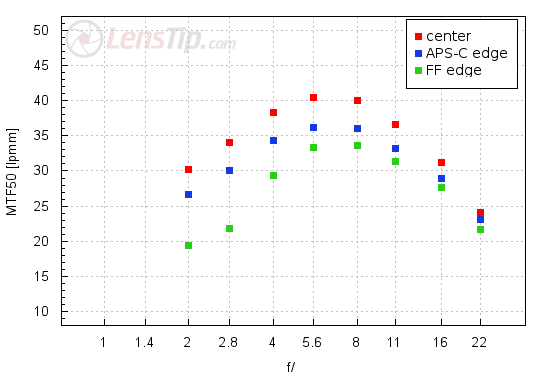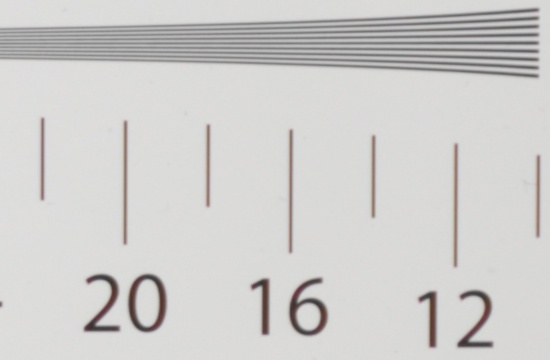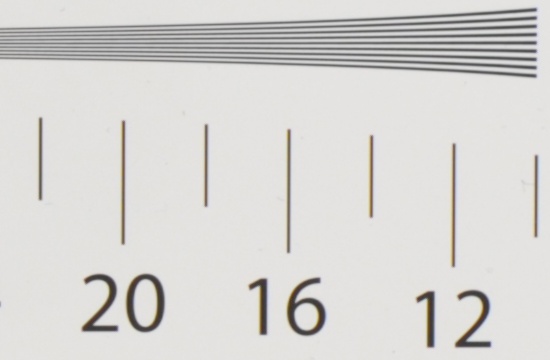Mitakon Creator 35 mm f/2
4. Image resolution
Let’s check how the tested lens compares here. The graph below shows its performance in the frame centre, on the edge of the APS-C/DX sensor and on the edge of full frame.

The first important and positive piece of information concerns a sensible performance at the maximum relative aperture. I have to admit that seeing small physical dimensions of the tested lens and its low price I didn’t expect any images taken by f/2.0 to be very useful. It seems I was wrong. The images are useful although it would be difficult to speak about any resolution records here. On stopping down the aperture the image quality improves but it is a slow process, especially when compared to the performance of the rivals. The Mitakon reaches the maximum of its possibilities by f/5.6 and f/8.0 where it exceeds very slightly a level of 40 lpmm. The new full frame Nikkor 1.8/35G didn’t have any problems with getting to almost 46 lpmm and similarly fared the Canon EF 2/35 IS USM. Still you have to remember that both these lenses are almost three times more expensive than the Mitakon and not necessarily of better build quality. Taking it into account our assessment of the tested lens remains still positive.
Please Support UsIf you enjoy our reviews and articles, and you want us to continue our work please, support our website by donating through PayPal. The funds are going to be used for paying our editorial team, renting servers, and equipping our testing studio; only that way we will be able to continue providing you interesting content for free. |
- - - - - - - - - - - - - - - - - - - - - - - - - - - - - - - - - - - - - - - - - - - - - - - -
The results presented on the edge of the APS-C sensor are only slightly worse than the performance in the frame centre. In order to get fully useful images you have to close the Mitakon down to near f/2.8. It’s also worth reminding here that even the faster Nikkor 1.8/35G was not fully useful by f/2.0. It should be emphasized that here the Mitakon is no longer worse than the expensive Nikkor – both instruments reach near 36-37 lpmm. The Canon 2/35 is only a tad better, with MTFs as high as 37-38 lpmm.
A demanding edge of full frame creates a lot of problems for such a small lens as the Mitakon. Images by f/2.0 and f/2.8 are far from full usefulness; in order to get it you have to close the aperture down to near f/4.0. The Nikkor 1.8/35G fares much better here because it produces images of sensible quality already by f/2.8. Still its maximum achievements barely exceed 32 lpmm and those of the Mitakon are as high as almost 34 lpmm – once again the better performance belongs to the cheaper lens! What’s more it is not so different from the performance of the Canon 2/35 IS which had to be closed down to near f/3.5 in order to be fully useful and could reach a value of about 33 lpmm.
To sum up we are very pleasantly surprised. A cheap and small lens from China is able to produce useful images in the frame centre starting already from the maximum relative aperture – it is undoubtedly an asset. It doesn’t break any resolution records and its maximum results are worse than those of its more expensive rivals but only in the frame centre. On the edge of the APS-C sensor and full frame it doesn’t have to be ashamed of its performance. Although near the maximum relative aperture the Canon and the Nikkor still prevail, on stopping down the Mitakon is actually better.
Traditionally we end this chapter with crops taken from photos of our test scene in the frame centre. It’s worth reminding here that these are JPEG files saved along RAW files we used for the analysis above.
| Nikon D3x, JPEG, f/2.0 |
 |
| Nikon D3x, JPEG, f/5.6 |
 |






